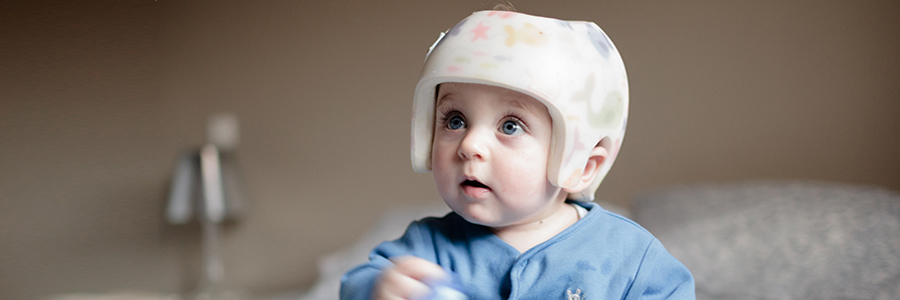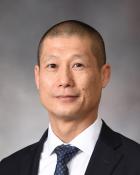Skull Shape Differences - Pediatric

A baby's skull is not hard like an adult’s. Instead, it is made of bone plates that are attached to one another with hinges or bridges, called sutures. Sutures are flexible, allowing the skull to deform and expand easily – particularly when passing through the birth canal. Within the first year of life, the brain triples in size. As a result, the skull needs to expand with this growth. This ability to expand enables the skull to adapt but can cause deformity in some cases. Sutures also have bone growth at the edges, which allows the skull to expand. Eventually they will fuse together, but this will not occur until early adulthood.
Another cause of skull deformity occurs when one of these sutures fuses prematurely or does not grow with the child. This can cause deformity as well as restrict brain growth.
Deformational Plagiocephaly vs. Craniosynostosis
When the skull is deformed from outside forces, such as sleeping on the back, this is called deformational plagiocephaly and does not require surgery. When the skull is deformed because one or more of the sutures are fused or not growing, this is referred to as craniosynostosis and requires surgery.
Deformational plagiocephaly can occur from constant pressure on a specific part of the head, usually the back of the head and/or on one side. Sometimes, if a child has torticollis (neck muscle spasms), this can cause the head to lie in a position that will cause it to flatten in a specific place. Because the brain continues to grow and push out the skull, the skull will naturally adapt and might push out at places making it asymmetric (see below). Because this is considered to be normal brain growth, your child’s brain development will not be affected.
Craniosynostosis can occur when the sutures themselves are either joined or fused too early. Unlike deformational plagiocephaly, the brain might not have enough room to grow, so surgery is necessary. There are two primary objectives of this surgery – opening of the suture to allow the brain to grow at its normal rate and shaping the skull back into a more symmetrical shape.
Why does it happen?
Deformational plagiocephaly is a natural response to constant pressure. Because the brain is the driving force for skull growth, the skull will contour itself in the path of least resistance. If the back of the head has constant pressure (from lying on it), the brain and the skull will continue to grow in the opposite direction in order to give enough space for brain growth. This is a normal response, and some cultures actually encourage this in order to shape their children’s heads into what they perceive to be more beautiful shapes. Mental development is normal.
The cause of craniosynostosis is still somewhat of a mystery, and most recent research demonstrates both genetic and local-tissue causes. Unfortunately, there is no test or exam that can predict whether or not a child will have craniosynostosis.
Treatment
Deformational plagiocephaly
To begin with, treatment methods usually change how the child sleeps and sits on the back of his or her head, increasing the time on their bellies. Other issues such as torticollis (neck muscle spasms) can prevent the head from turning naturally and can either cause or worsen the plagiocephaly. Physical and occupational therapy is required to help stretch out and strengthen the neck muscles.
If these initial approaches do not prove helpful, a shaping helmet may be prescribed. The shaping helmet is custom-made for the child. It relieves pressure from the flattened area, allowing the head to fill out into a more rounded shape. Depending on the severity of the conditions, helmets can be prescribed anywhere from 4 months to 8 months of age. Evaluations are done on a case-to-case basis.
Craniosynostosis
Because the skull will not grow in the spot where the suture is fused, the rest of the skull must compensate for this lack of growth. The result is asymmetry, or lopsided growth. Also, depending on which suture is fused, there can be increased brain pressure because the brain is outgrowing the skull.
Treatment for craniosynostosis is surgical. Through an incision across the top of the head, the fused suture is removed to provide more room for the brain to grow, and at the same time, the lopsided areas of the skull are broken and remodeled to look more symmetrical on both sides. This is a procedure done by both pediatric plastic surgeons and a pediatric neurosurgeon. Following the operation, the patient typically spends one night in the pediatric intensive care unit. The next day, the child is usually transferred to the children’s hospital floor, where he or she will typically spend another three to five days.
The skull is fixed using special plates that eventually dissolve away, usually after nine months. By this time, the skull has healed to its normal strength level, and after another six months, a special CT scan is ordered to ensure everything is healing as planned. Because the plates are strong now and will not break with routine activity, there is no need for a helmet or special precautions after the surgery.
NOTE: The previous descriptions and notes are intended to give an overview and are not at all comprehensive. Should you have any questions or concerns, please do not hesitate to contact UK Pediatric Plastic Surgery for a clinic consultation.

